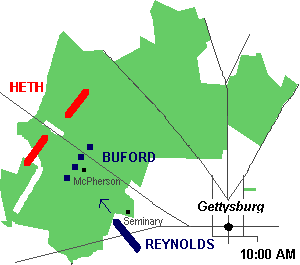Gettysburg: July 1, 1863- The Battle Begins
"These were days of fear and uncertainty."
The battle began early on the morning of July 1 when a Confederate column under General Henry Heth, marching east from Cashtown encountered Union pickets three miles west of Gettysburg. Opponents sparred over the gently rolling farmland west of Gettysburg, until the cavalrymen were forced back to McPherson's Ridge where Union infantry were just then arriving at 10 AM.
 Some of Heth's Confederates reached McPherson's Ridge where they were hit by a vigorous Union infantry counterattack and forced back. North of the Chambersburg Pike, other Confederates were briefly victorious before they, too, were counterattacked, many being forced to surrender in the railroad cut. One of the first officers to fall was Major General John Fulton Reynolds, commander of the Union First Corps, instantly killed as he led his troops into the fray.
Some of Heth's Confederates reached McPherson's Ridge where they were hit by a vigorous Union infantry counterattack and forced back. North of the Chambersburg Pike, other Confederates were briefly victorious before they, too, were counterattacked, many being forced to surrender in the railroad cut. One of the first officers to fall was Major General John Fulton Reynolds, commander of the Union First Corps, instantly killed as he led his troops into the fray.
A brief noon-time lull gave commanders on both sides time to plan and augment their battle lines. Union troops manned a jagged line extending from the McPherson Farm northward along Seminary and Oak Ridge with troops of the Eleventh Army Corps, which had just arrived, were deployed north of Gettysburg on the grounds of the county Alms (Poor) House. Confederate forces were arrayed against this line in heavier numbers, with more troops expected to arrive at any moment. The battle was renewed at 2 PM when Confederate forces attacked McPherson's Ridge and Oak Ridge. Union troops fought desperately, repulsing the attacks with heavy losses to both sides. General Lee arrived on the battlefield and though a battle had been initiated against his orders, he immediately saw an opportunity. Having already ordered his troops east of Gettysburg to concentrate near the town, Lee allowed the attack to continue knowing that the battered Union line would be pressured from three directions as soon as General Richard Ewell's Corps arrived from the direction of Dover, Pennsylvania.
After two hours of desperate fighting, it was apparent to General Abner Doubleday, commanding the First Corps after the death of Reynolds, that none of the ridges west of Gettysburg could be held and he ordered a fighting withdrawal to Seminary Ridge. North of Gettysburg, the Eleventh Corps was in a predicament with too few troops to defend a large area. Some Union regiments dissolved as Ewell's Confederates hit them from three directions at once while others valiantly fought back, losing scores in killed and wounded including General Francis Barlow being among the latter.
The Union line finally collapsed and thousands of Union soldiers pushed headlong through the streets, yards and alleys of Gettysburg, many taking refuge in outbuildings and churches already filled with the wounded and dying. Terrified citizens fled to their cellars while others risked their lives to help the injured. Those who could find their way to Cemetery Hill were met by General Winfield S. Hancock, sent to Gettysburg by General Meade, and reorganized into a line of defense from Cemetery Ridge to Culp's Hill. General Lee entered Gettysburg and located General Ewell who he requested him to continue his attack south of Gettysburg "if practicable". Unable to consolidate his forces before nightfall and with the threat of a large Union force on his left, Ewell deferred. The sounds of battle slowed to a murmer as night fell. Exhausted soldiers of both armies collapsed beside stone walls and fences, in fields and woods, and streets and alleys to wait for the fighting to resume on the morrow.
July 1 was a great victory for General Lee, but not a decisive one. Though the Union forces had been badly mauled, they had retreated to a strong position south of Gettysburg. General Meade arrived on the battlefield near midnight and after discussions with his corps commanders, decided to wait for the rest of his army to concentrate around Cemetery Hill. Come the morning of July 2, he would attack Lee or defend the prominent hills where his men now rested. Lee, meanwhile, seated in his headquarters tent on Seminary Ridge, pondered the growing strength of the Union position south of Gettysburg. If only he could hear from his cavalry chief J.E.B. Stuart and information he could provide about the remainder of the Union army.